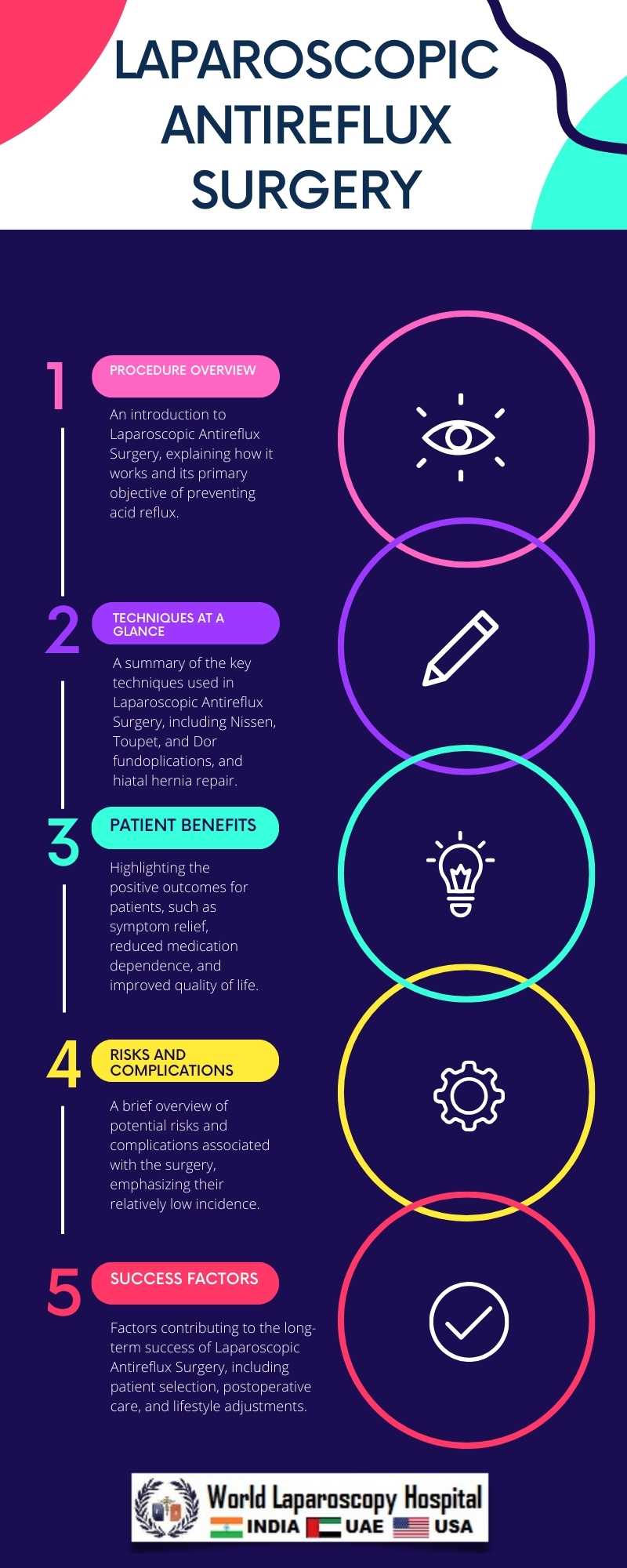Gastroesophageal Reflux Disease (GERD) is a common medical condition that affects millions of people worldwide. It occurs when stomach acid frequently flows back into the esophagus, causing symptoms such as heartburn, regurgitation, and chest pain. While lifestyle modifications and medications can alleviate GERD symptoms, some individuals require surgical intervention when conservative measures fail. One of the most effective and minimally invasive surgical approaches for managing GERD is Laparoscopic Antireflux Surgery. In this article, we will delve into the world of Laparoscopic Antireflux Surgery, exploring the techniques involved and examining the outcomes achieved through this procedure.

Section 1: Understanding GERD and its Impact
Before delving into the techniques and outcomes of Laparoscopic Antireflux Surgery, it is essential to understand GERD and the impact it has on patients' lives. GERD occurs when the lower esophageal sphincter (LES) weakens or relaxes abnormally, allowing stomach acid to flow back into the esophagus. This chronic condition can lead to various complications, including esophagitis, Barrett's esophagus, and even esophageal cancer.
GERD not only affects a patient's physical health but also their quality of life. The constant discomfort, pain, and limitations in diet and lifestyle can significantly impact an individual's well-being. Medications like proton pump inhibitors (PPIs) may provide temporary relief, but they do not address the root cause of the problem. For those who seek a long-term solution, Laparoscopic Antireflux Surgery offers hope.
Section 2: Laparoscopic Antireflux Surgery - The Basics
Laparoscopic Antireflux Surgery, often referred to as fundoplication, is a minimally invasive surgical procedure designed to treat GERD. The key objective of this surgery is to strengthen the LES, preventing stomach acid from refluxing into the esophagus. Unlike traditional open surgery, which involves a large abdominal incision, laparoscopic surgery is performed through small incisions using specialized instruments and a camera.
The surgeon begins by making several small incisions in the abdomen to access the surgical area. They then use a laparoscope (a thin, flexible tube with a camera) to visualize the internal structures. The surgeon wraps the upper part of the stomach, known as the fundus, around the lower esophagus and sutures it in place. This creates a valve-like mechanism that prevents acid reflux.
Section 3: Techniques of Laparoscopic Antireflux Surgery
3.1. Nissen Fundoplication
The Nissen Fundoplication is one of the most common techniques used in Laparoscopic Antireflux Surgery. During this procedure, the fundus of the stomach is wrapped entirely around the lower esophagus to create a 360-degree anti-reflux barrier. This technique is highly effective in preventing acid reflux but can sometimes lead to side effects such as dysphagia (difficulty swallowing) or gas-related issues.
3.2. Toupet Fundoplication
The Toupet Fundoplication is a partial fundoplication technique that involves a 270-degree wrap of the fundus around the esophagus. It is often chosen when the surgeon aims to achieve reflux control while minimizing the risk of postoperative dysphagia. This technique can be especially suitable for patients with impaired esophageal motility.
3.3. Dor Fundoplication
The Dor Fundoplication is another partial wrap technique that involves a 180-degree fundoplication. It is commonly used for patients with mild to moderate GERD symptoms. The Dor Fundoplication offers good reflux control while reducing the risk of side effects like dysphagia.
3.4. Hiatal Hernia Repair
In many cases, GERD is associated with a hiatal hernia, where a portion of the stomach protrudes through the diaphragm into the chest cavity. During Laparoscopic Antireflux Surgery, the surgeon may also repair the hiatal hernia, restoring the normal anatomy and further preventing acid reflux.
Section 4: Outcomes of Laparoscopic Antireflux Surgery
4.1. Symptom Relief
One of the primary goals of Laparoscopic Antireflux Surgery is to provide long-lasting relief from GERD symptoms. Studies have shown that the majority of patients experience significant symptom improvement or complete resolution after the procedure. Heartburn, regurgitation, and chest pain are often greatly reduced or eliminated.
4.2. Medication Reduction
Patients who undergo successful Laparoscopic Antireflux Surgery typically require fewer or no medications to manage their GERD. This not only improves their quality of life but also reduces the long-term costs associated with medication use.
4.3. Quality of Life
Improved quality of life is a crucial outcome of Laparoscopic Antireflux Surgery. Patients can resume a normal diet, enjoy social activities, and experience relief from the physical and psychological burdens of GERD. This surgery can significantly enhance a patient's overall well-being.
4.4. Complication Rates
Laparoscopic Antireflux Surgery is considered a safe procedure with low complication rates. While no surgery is entirely risk-free, the overall incidence of serious complications is relatively rare. Common postoperative issues may include temporary dysphagia or gas-related discomfort, which typically resolve with time.
4.5. Long-Term Success
Studies have demonstrated that Laparoscopic Antireflux Surgery provides durable results, with most patients experiencing long-term relief from GERD symptoms. However, it's essential for patients to follow postoperative dietary and lifestyle recommendations to maintain the benefits of the surgery.
Section 5: Patient Selection and Preoperative Evaluation
Not every GERD patient is a candidate for Laparoscopic Antireflux Surgery. Careful patient selection and thorough preoperative evaluation are critical to ensure successful outcomes. Factors such as the severity of GERD symptoms, esophageal motility, the presence of hiatal hernias, and the patient's overall health must be considered when determining candidacy.
Conclusion
In conclusion, Laparoscopic Antireflux Surgery is a highly effective and minimally invasive technique for managing GERD. It offers patients the opportunity to achieve lasting relief from symptoms, reduce or eliminate the need for medications, and improve their overall quality of life. While the surgery is not suitable for everyone, careful patient selection and the use of appropriate techniques can lead to excellent outcomes.
As a surgeon in Gurugram, mastering the techniques and outcomes of Laparoscopic Antireflux Surgery can enhance your ability to provide effective treatment to patients suffering from GERD. It is a valuable skill that can make a significant difference in the lives of those seeking relief from this chronic condition.